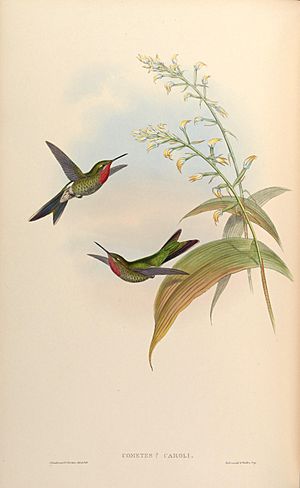Bronze-tailed comet facts for kids
Quick facts for kids Bronze-tailed comet |
|
|---|---|
 |
|
| Conservation status | |
| Scientific classification | |
| Genus: |
Polyonymus
|
| Species: |
caroli
|
The bronze-tailed comet (scientific name: Polyonymus caroli) is a special type of hummingbird. It belongs to a group of hummingbirds called "coquettes." This amazing bird lives only in Peru, which means it is endemic to that country.
Contents
About This Hummingbird
The bronze-tailed comet is quite unique! It's the only bird in its entire group, called a genus. This means there are no other types or subspecies of the bronze-tailed comet.
A long time ago, another bird called the grey-bellied comet was thought to be part of the same group. But now, scientists know they are different.
What Does It Look Like?
The bronze-tailed comet is a small bird, about 11 to 13 cm (4.3 to 5.1 in) long. That's roughly the length of a pen! It weighs around 4.8 g (0.17 oz), which is lighter than a single coin.
Male Birds
Adult male bronze-tailed comets have shiny, dark bronze-green feathers on their upper bodies. Their tail is quite long and shaped like a deep fork. The middle feathers of the tail are also bronze-green. The other tail feathers look steel blue or purple on top, turning bronze at the ends. Underneath, they are completely steel blue.
Males have a small white spot right behind their eye. Their throat area, called a gorget, is large and can be rosy violet or rosy purple. The rest of their underside is a bronze-green color.
Female Birds
Female bronze-tailed comets look similar to the males but are a bit duller in color. Their gorget is smaller and more orange. Their tail is also shorter and not as deeply forked as the male's. The belly of the female is grayish with small green speckles.
Where Does It Live?
The bronze-tailed comet lives in the Peruvian Andes mountains. You can find it on the western side, which faces the Pacific Ocean. It also lives in the dry valleys of these mountains. Its home stretches from the Department of Cajamarca in the north down to the Department of Arequipa in the south.
This hummingbird likes to live in dry or semi-dry areas. It prefers mountain scrublands and small mountain forests. You can find it at high elevations, from about 2,100 to 3,400 m (6,900 to 11,000 ft) above sea level.
How Does It Behave?
Movement and Travel
The bronze-tailed comet does not travel far. It stays in the same area all year round. Scientists call this being "sedentary."
What Does It Eat?
We don't know all the details about what the bronze-tailed comet eats. However, we do know it mostly eats insects. It also enjoys small arthropods, which are creatures like spiders or tiny bugs. This bird looks for food at all different heights, but it often searches closer to the ground.
Breeding and Nests
The breeding season for the bronze-tailed comet seems to happen around November and December. But not much else is known about how or when they raise their young. Scientists have not yet found or described their nests.
What Sounds Does It Make?
The song of the bronze-tailed comet is described as a short trill. This trill starts low, rises in pitch, and then goes back down. When it is looking for food, it makes a quick, dry chattering sound. This sound is like "tcht" or "tchtcht."
Is It Endangered?
The IUCN (International Union for Conservation of Nature) has looked at the bronze-tailed comet. They have decided it is a species of "Least Concern." This means it is not currently considered to be in danger of disappearing.
We don't know exactly how many of these birds there are. However, experts believe their numbers are staying steady. The bronze-tailed comet is not very common, but it lives in parts of the Andes mountains where people have lived for thousands of years. For now, human activities don't seem to be harming this bird much.
See also
 In Spanish: Polyonymus caroli para niños
In Spanish: Polyonymus caroli para niños


